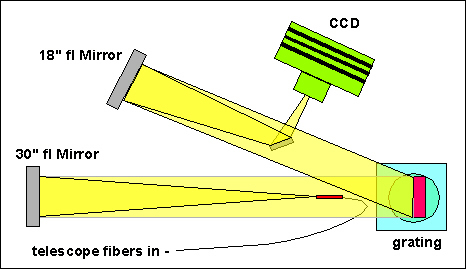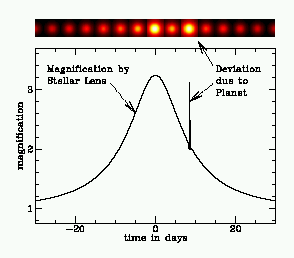Professional Astronomers use very large telescopes
and highly sensitive
spectrometers to look of
changes in a
stars characteristics. Such methods
include:
- Photometric changes in stellar brightness
- Radial velocity measure of a stars "wobble"
Additional methods include:
- Astrometry - precise measurements of a star
path along the celestial sphere
- Microlensing - the act of altering a path of
light by the result of an unseen massive object
(like a planet)
- Optical and Infrared Interferometry - by
combing the light from two or more telescopes,
resolution is greatly increased
The rule of professional detection is increased
spectrometer sensitivity and improved resolution.
For
spectrometer sensitivity:

An Echelle type
spectrometer - like the image
above - is the preferred style. There are five
methods used to increase a
spectrometers
sensitivity:
- Increase the number of grooves cut into a
diffraction grating
- Improved fiber optic quality
- Extending the focal length of the light
inside the spectrometer
- Improved resolution of the
CCD camera
- Introduce Iodine gas through which light
must pass prior to entering the slit of the
spectrometer
The last method has been used the pioneering
gurus of
exoplanet detection Geoff Marcy and Paul
Butler. By introducing iodine gas, the overall
spectrum is enhanced and provides an iodine line on
the spectra to act as a ruler for helping to
increase accuracy in measurements.
The improved
spectrometer is designed to increase
sensitivity of detecting the "wobble" of a star:

and also to determine of an atmosphere is present
on the unseen planet (a spectra of a star is known,
so any added spectra will be assumed to be a part of
the planets atmosphere). This wobbling will affect
the stars path along the sky. By using precise
Astrometric measurements, the net effect can be
determined by comparing the predicted path of the
star with the actual path. Microlensing if fairly
new, but light from the star should be affected by a
transiting planet:

Interferometry is the method of determining phase
changes in an electro-magnetic signal. These changes
are overlapped to cancel out any ambient noise so
only the desired signal is enhanced. Radio
Interferometry has been used for some time, and
essentially is used to create a much larger, virtual
disk that can detect larger wavelengths. Optical
Interferometry is much more challenging since the
wavelengths are much smaller. Unlike radio
Interferometry where the distortions of the
atmosphere result in phased distortion, more precise
measure of small wavelengths are possible - but the
sources of these short wavelengths are often very
dim so optical interferometer components must
include very large telescopes. Take a
look at the
Additional Resource section to get up to date
information direct from the pioneers in the field.
Back to Top |

